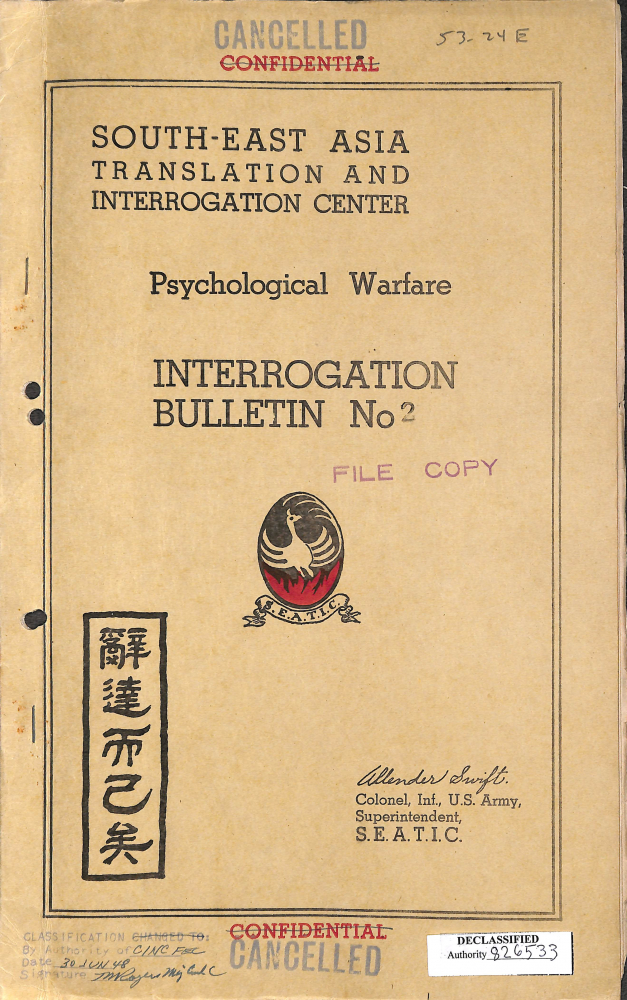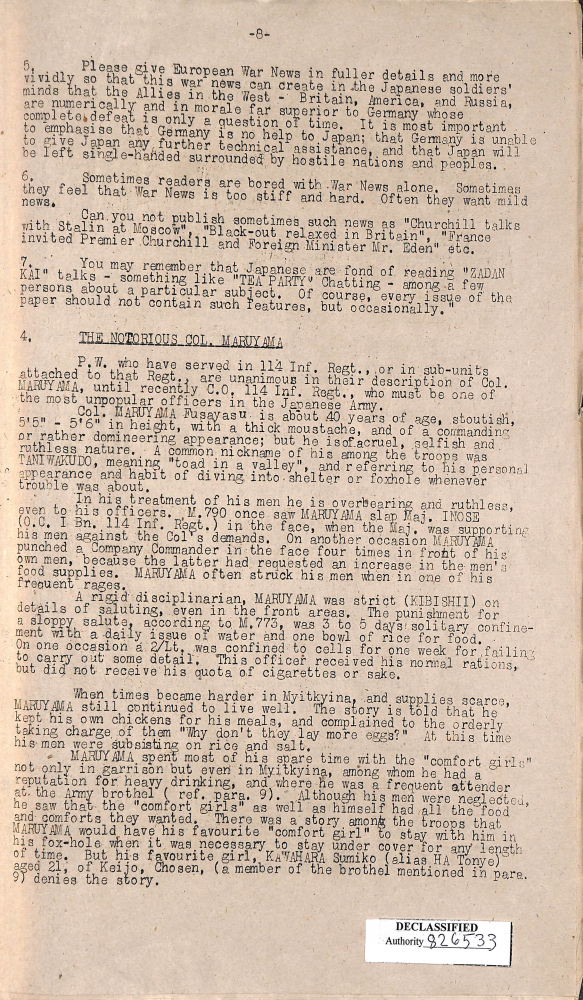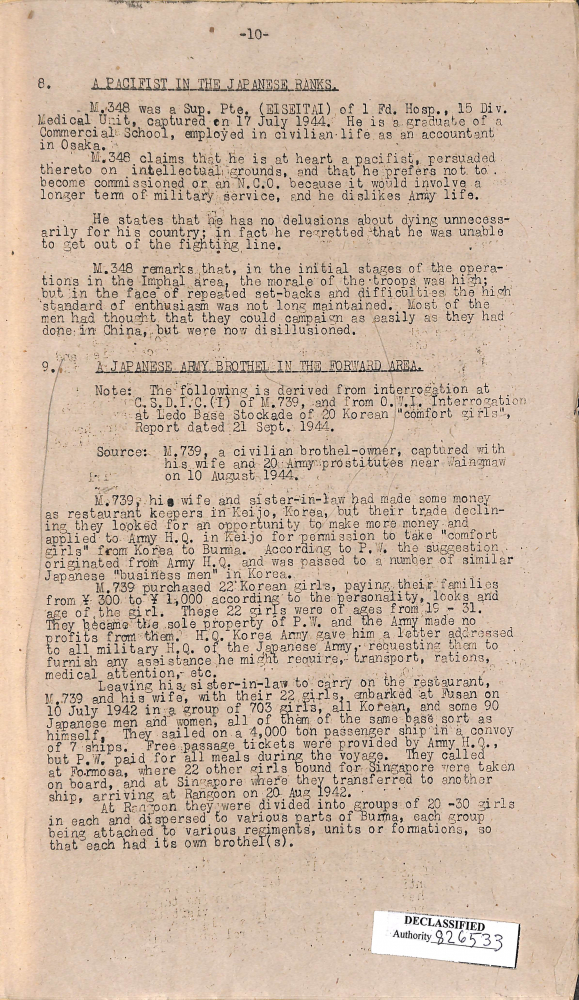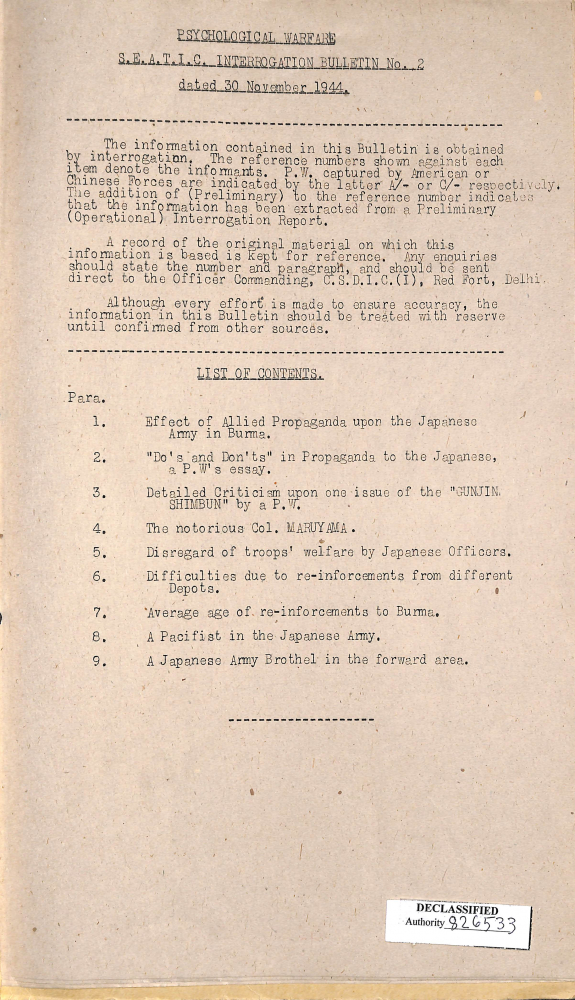While Japanese Prisoner of War Interrogation Report No. 49 of Office of War Information (OWI) contains explicit biases of Alex Yorichi, Japanese-American writer, Interrogation Bulletin No. 2 of South-East Asia Translation and Interrogation Center (SEATIC) that will be introduced in the following provides relatively objective information about the realities of operation of comfort stations. Comparing these two documents, I intend to examine the contents of Interrogation Bulletin No. 2.
Background of production of Interrogation Bulletin No. 2
SEATIC is an organization similar to Allied Translator and Interpreter Section (ATIS)of South- West Pacific Command, which established and operated units dedicated to psychological warfare and prisoner interrogation with different names depending on each region. This group was led by British army,but also served as a kind of combined organization in that U.S. military occasionally assumed deputy commander roles. Interrogation Bulletin No. 2 was produced by its psychological warfare team in charge of collecting and analyzing various information for such purposes, but this document was not a direct record of prisoners’interrogation, but rather a secondary paper based on already secured interrogation reports. That is, while the OWI Interrogation Report No. 49 was written based on direct interrogations of 20 Korean "comfort women," the SEATIC Interrogation Bulletin No. 2 is a comprehensive document resulted from integrating a variety of sources along with Report No. 49.
Interrogation Bulletin No. 2 was produced on November 30, 1944, and consists of 13 pages covering a total of 9 paragraphs: 1. Effect of Allied Propaganda upon the Japanese army in Burma; 2. prisoner’s essay; 3. Prisoners’ evaluation of military newspaper; 4. the notorious Colonel Maruyama; 5. disregard of troops’ welfare by Japanese officers; 6. difficulties due to troop reinforcement; 7. average age of Japanese reinforcement to Burma; 8. a pacifists in the Japanese Army; and 9. a Japanese Army brothel in the forward area. Out of these, two paragraphs including par. 4. (the notorious Colonel Maruyama) and par. 9 (a Japanese Army brothel in the forward area) are related to "comfort women”.
Comfort women’s testimonies of Colonel Maruyama
Col. Maruyama was the defense force commander in Myitkyina and also took control of Myitkyina comfort station. As of March 27, 1943, he was appointed as a colonel of the Japanese Army’s 18th Division 114th Regiment stationed in Myitkyina, Burma. During the Myitkyina operation conducted by the Allied forces afterwards, it seems that he barely managed to escape with a small number of troops left.
It appears that he was infamous so much as to be described in an independent paragraph ‘the notorious Col. Maruyama’ in the document. He was said to have bitten his men frequently and even officers suffered from his violence like being slapped in front of their own men. In addition, when times became harder for his men with scarce supplies, Maruyama still continued live well alone, and repeatedly engaged in cowardly behavior, eventually losing his men’s trust. Maruyama was also a frequent attender at the comport station, where he not only cut the fare, but also reduced the allocation rate of profit the ‘comfort women’ received from 60% to 50%. The comfort girls depicted him as a ruthless and inhumane person as his men did, and he was also notorious for a heavy drinker.
Likewise, the testimonies from both prisoners and "comfort women" regarding Col. Maruyama were sustainedly negative, but he is said to provide food and conveniences to the ‘comfort women’ on the other hand. There was a famous story that even when fleeing, he always took his favorite “comfort girl’ along and have her to stay with him for many hours in a shelter. However, it was reported that Kawahara Sumiko (alias Ha Tonye), a Korean "comfort girl", who was known to be his favorite, denied the story. Additionally, it is stated that Kitamura, owner of the comfort station, wore the same pants when he became a prisoner as Maruyama's riding pants. Sumiko herself also was reported to have worn Maruyama's sword belt instead of her waistband.
It would be hasty to determine who Col. Maruyama really was and to what extent he exerted influence on operation of the comfort station, and how his relationship with "comfort women" was. There is a need for supplement to our understandings from more sources, but for now, it’s safe to say that this is a rare document that provides insight into relationship between operation of the comfort station and the Japanese military commander.
Information that Report No. 49 couldn’t tell
Considering "comfort women", the core part of Interrogation Bulletin No. 2 lies in a Japanese Army brothel in the forward area described in par. 9. The statement in this paragraph is entirely based on two sources: one is derived from the interrogation report of Kitamura Eibun, who was a brothel owner and referred to as M. 739; and the other is from the previously introduced popular Report No. 49. The latter has gained widespread attention, but unfortunately, Kitamura's interrogation report has not been found until today.
An interesting thing is that the introductory statement reveals information indicating that interrogation of M. 739 was conducted at the Combined Services Detailed Interrogation Centre (CSDIC) of the British forces. In other words, the interrogation of 20 Korean "comfort women" took place at the Ledo base in the India-Burma border area, whereas there is a high chance that Kitamura's interrogation was conducted in New Delhi, India. The timing when these two reports were written is also intriguing. Though on September 21st, Report No. 49 was submitted, Interrogation Bulletin No. 2 was produced on November 30th and prepared for routine distribution on December 7th. Despite the fact that the interrogation report of Kitamura, who were captivated in August, was created in September, another interrogation of him took place about two months later and that’s when Interrogation Bulletin No. 2 was written. This case demonstrates that the Myitkyina battle and the Korean "comfort women" who became prisoners as a result of the battle have such a great significance to the Allied forces.
In a broad framework, the depictions of the Myitkyina comfort station in Interrogation Bulletin No. 2 are consistent with those of Report No. 49, but differences exist in their contents. In terms of length, Interrogation Bulletin No. 2 is about 4 pages long while report No. 49 has 6 pages. If you examine what is the difference, first of all, Interrogation Bulletin No. 2 contains the numbers and nationalities of "comfort women" per each comfort station. It is mentioned that there were 22 Korean women at the Kyoei comfort station, 20 Korean women at the Kinsui comfort station, and 21 Chinese women at the Momoya comfort station. Such information is not found in Report No. 49.
Furthermore, Interrogation Bulletin No. 2 contains information that Chinese "comfort women" were sold from the Guangdong province, and Japanese "comfort women" were never seen at the frontline but only present in rear areas. Such information, which is not found in report No. 49, appears to have derived from the testimony of comfort station owner, Kitamura. The reason why this sort of information was absent in Report No. 49 of which interrogation came only from "comfort women" may be because these girls had few news and information about neighboring comfort stations.
In addition, difference between two documents exists in descriptions about repatriation of "comfort women." According to record of Report No. 49, some "comfort women" were allowed to return home under military order in the latter half of 1943. In Interrogation Bulletin No. 2, however, it is stated that the comfort women had a chance to come back home if they paid their advance payments, but due to the wartime situation, none of them actually returned from the comfort station operated by M. 739. There is a story that in June 1943 when one of the "comfort women", who met the required conditions, desired to return home after obtaining an order of repatriation issued by the 15th Japanese Army Command, but she succumbed to persuasion to remain in the end.
Interrogation Bulletin No. 2 includes more detailed depiction of situation regarding operation of comfort station with information from Kitamura’s interrogation. It is revealed that the 114th Regiment controlled the comfort station, and the name of an officer in charge is confirmed. It was Captain Magasue at the 114th Regiment headquarters and reportedly he enforced strict control over users of the comfort station. Typically, two soldiers were dispatched from the headquarters to handle access to the comfort station, and soldiers from other units were allowed to enter if accompanied by those soldiers from the 114th Regiment. It’s said that 80 to 90 noncommissioned officers and enlisted men, and 10 to 15 officers visited there on a daily basis. Also, there were military police going around for regular patrols to control incidents such as fights.
Another piece of information absent in Report No. 49 is related to venereal diseases. According to Kitamura, during his one-and-a-half-year operation of the comfort station, only six cases of venereal disease infection were reported. There is also a description of Japanese soldiers' complaints, which were primarily about conflict with officers, supply shortages, and homesickness.
As for retreat and process of becoming prisoners, it’s described that 20 Chinese "comfort women" surrendered to the China’s military and how "comfort women" were suffered from damage during the retreat. Out of the 63 "comfort women," four died in the course of moving and two girls were mistakenly identified as Japanese soldiers before killed.
The most significant characteristic of Interrogation Bulletin No. 2 when compared to Report No. 49 is that the author’s subjective evaluations or biased descriptions are found nowhere. This document is focused only on factual aspects extracted from both Kitamura's testimony and the content of Report No. 49 and written in a relatively dry style. For instance, while it is clear that a regulation existed for granting repatriation eligibility upon repayment of the advance payment, but how this was carried out on the real situation presents another issue. According to Report No. 49, some "comfort women" could return whereas Kitamura stated that none of them came home from his comfort station. It’s not clear whether the 20 Korean "comfort women" stated about what they’d heard of conditions in other comfort stations, it's identified that no comfort girl working in Kitamura’s comfort station came back home.
As mentioned above, Interrogation Bulletin No. 2 furnishes valuable information on its own, but also has exceptional significance in that it indicates the limitations and shortcomings of Report No. 49. In case an interrogation report of Kitamura, defined as M. 739, is discovered, it is expected that a more accurate confirmation of factual details would be allowed when compared with Report No. 49 and Interrogation Bulletin No. 2.
Related contents
-
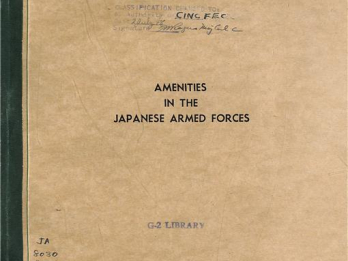
- Allied Translator and Interpreter Section (ATISP) Research Report No. 120
-
The data that exists on the Japanese Military ‘Comfort Women’ is classified into several categories. First of all, we have the data produced by the Japanese military, which acted as the principal for the organization and operation of the comfort stations. It is the most accurate data as it was created by the directly involved parties. A considerable amount of data has been unearthed that describes the installation and operation of the comfort stations, allowing us to fully grasp the harsh reality and identify the complete responsibility of the Japanese military. However, a large amount of the data created by the Japanese military have since vanished due to the organized destruction of the pertinent materials, which has made it intrinsically difficult to bring the remaining data to light owing to various circumstances.
-
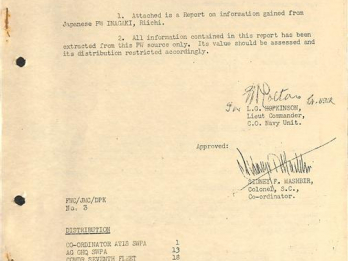
- The most elementary data among the ‘comfort women’-related records of the Allied Forces
-
Hwang Byoung-joo The author's interest lies in the modern transformation of Korea and he conducts relevant studies. He is currently involved in the project related to the war crimes of the Japanese military against ‘comfort women’ at the National Institute of Korean History.
-
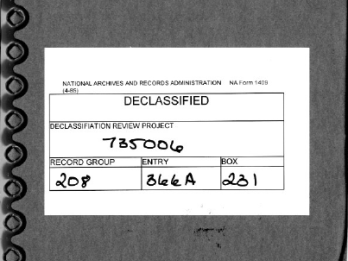
- U.S. Office of War Information Report No. 49: A report reflecting the author’s subjective bias
-
Japanese far-right forces have been attacking Japanese Military “Comfort Women” victims based on the U.S. Office of War Information (OWI) Report No. 49.
- Writer Byeongju Hwang
-
Byeongju Hwang is a research officer at the National Institute of Korean History, focusing on the modern transformation of Korea. He is currently responsible for the project on the war crimes of Japanese Military “Comfort Women” at the National Institute of Korean History.
aviantibj@gmail.com
